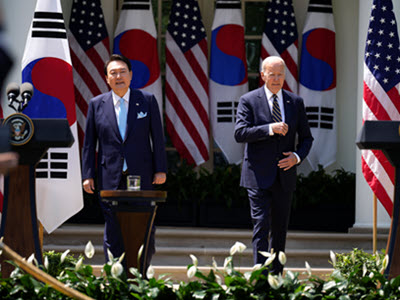Commentary from The U.S.-ROK Next Generation Leaders Program
Aligning South Korean and U.S. Economic Security Priorities
Daniel Rechtschaffen argues that keeping South Korea’s specific interests front of mind in U.S. policymaking is crucial to ensuring continued alignment on U.S. technology and trade goals.
On the surface, economic relations between the United States and the Republic of Koea (ROK) appear to be flourishing. The Yoon Suk-yeol administration, which took office in May 2022, quickly outlined an expansive vision of national security and Indo-Pacific priorities that aligns closely with many of President Joe Biden’s goals. This seemingly full-throated endorsement was seen by many in Washington as a clear contrast to the previous ROK administration’s more ambiguous approach of balancing between U.S. and Chinese interests and finding a middle ground in an attempt to not aggravate either great power.
The alignment between U.S. and ROK priorities is especially evident in the ROK’s emphasis on “economic security,” which the Yoon administration in June 2023 elevated to a “core tenet” in the country’s National Security Strategy. President Yoon has also worked to institutionalize this priority across the policymaking process, including by creating a new office directly under the president to oversee its implementation.
Although loosely defined, economic security for Yoon broadly means ensuring supply chain resiliency, safeguarding South Korea’s technological dominance, and countering economic coercion. As ROK officials emphasized in remarks to a recent delegation to Seoul and Busan organized by the National Bureau of Asian Research (NBR) and the Korea Foundation (KF), decades of globalization have led to the centralization of certain critical supply chains. The risks associated with these dependencies have been made brutally evident as external shocks such as the Covid-19 pandemic and geopolitical conflicts such as the war in Ukraine have led to shortages of various items crucial for maintaining a healthy economy. This has led many countries around the world, the ROK included, to link economic and security issues in policymaking.
More controversially, Yoon’s vision of economic security specifically includes closer alignment with the United States. Since taking office in 2022, Yoon has expanded cooperation with and investment in U.S. high-technology industries (particularly semiconductors, clean technologies, batteries, and electric vehicles). Enthusiastic endorsements from both governments as well as generous subsidies from the United States have led ROK companies to announce more than $100 billion in U.S. “critical sectors” since 2021, a sharp increase in foreign direct investment that has made the United States the ROK’s top overseas destination. South Korea has also joined the U.S.-led Indo-Pacific Economic Framework—expressing particular interest in the supply chains pillar—and launched new bilateral dialogues and working groups with the United States on critical mineral supply chains, export controls, and critical and emerging technologies. Yoon also expended significant political capital to improve relations with Japan and expand trilateral economic security initiatives with the United States and Japan—which Washington strongly encouraged—including an early-warning system on critical minerals and battery supply chain disruptions.
Despite these positive developments, an enduring debate persists within South Korea regarding how much to support the United States’ hard line on China. ROK officials who met with the NBR and KF delegation expressed alarm over China’s new export controls on graphite, gallium, and germanium as well as over recent instances of technology leakage and corporate espionage. But they also consistently reminded us that Washington considers China more of a national security threat than Seoul does. For all of the Yoon administration’s embrace of the United States, this difference in threat perception limits the extent of U.S.-ROK alignment. So do a number of other factors.
First, Seoul is acutely aware of China’s economic leverage over it, which makes the ROK’s risk profile very different from the United States’. Officials repeatedly referenced the controversy in 2016 over the deployment of Terminal High Altitude Area Defense (THAAD). A U.S. announcement that it would deploy this advanced missile defense system in South Korea led to Chinese retaliation against Korean companies. This behavior led to pushback from the ROK government, but the spat finally ended in October 2017 only after South Korea announced its “three no’s”: no additional THAAD deployments, no integration into a wider U.S. regional missile defense system, and no trilateral alliance with the United States and Japan. Significant harm, however, had been done to ROK business interests in China. Although Seoul did not blame the United States for the backlash, the incident inevitably gave rise to feelings in South Korea that the country could get burned in a wider competition between great powers.
Second, industry and officials told the NBR and KF delegation that complete decoupling, or what would be considered an acceptable amount of economic security in some sectors, particularly critical minerals, is nonviable. Not only is it physically impossible to move mineral reserves from one continent to another, but labor costs, environmental issues, and supply chain realities make it difficult to even shift the extraction and processing of certain critical minerals to new countries where deposits are plentiful. Both the ROK government and industry expressed strong enthusiasm for joining as many critical mineral partnerships as possible to reduce reliance on any one importer. However, they did not express optimism that the scale and scope of shifts that the United States is encouraging are possible “even within the next decade,” as one industry leader said about nickel.
Third, many Korean companies repeatedly find themselves battling against U.S. policy. Some of their concerns are fixable by the White House, such as the subsidy provisions for domestic electric vehicle and lithium battery manufacturing in the Inflation Reduction Act, the export controls on advanced computing semiconductors and related technologies, and the provisions of the CHIPS and Science Act prohibiting recipients of funding from expanding operations in China. All these policies have significantly strained Washington’s political and economic relationship with Seoul. Moreover, they have negatively affected Korean companies and demonstrated how U.S. policies narrowly focused on domestic concerns can catch U.S. allies off guard and erode trust and goodwill. While some of these concerns have been assuaged through measures such as the granting of indefinite export control waivers for Samsung and SK Hynix, South Korean industry and government officials have highlighted the need for more transparency and predictability in U.S. policymaking.
Finally, basic economic realities exert downward pressure on the desire to invest in U.S. manufacturing. It is no secret that U.S. labor and construction costs are much higher than in Asia. That simple fact is the primary driver behind offshoring in the globalized era. While U.S. subsidies can remove some of the excess costs—one industry executive who spoke with the NBR and KF delegation pegged the costs of simply building a semiconductor fab in the United States as at least 30% more expensive than in Asia—the investment is still questionable if the only considerations are economic and not geopolitical. But strategic planning takes more into account than just revenue. Representatives from one company told the delegation that they also consider the value of a good relationship with the U.S. government when making decisions to invest in the United States.
The United States needs to remain keenly aware of its allies and the multivariate economic and geopolitical pressures they face. Despite many risks, Korean companies are investing heavily in the United States, but Washington should not misinterpret this as a wholesale adoption of its strategic outlook. A wide range of factors specific to South Korea drive these companies’ decision-making and the speed with which such policies are adopted. As numerous stakeholders pointed out to us, many sensitive South Korean investments in China, such as those in semiconductors, were made at a much more harmonious time in China’s relationship with the United States and its allies. The demand for Korean companies to extricate those investments is unreasonable and in some cases, such as memory semiconductors, would only cede ground to Chinese competitors, which does not serve U.S. interests.
The ROK is a useful ally to the United States, and under the Yoon administration it is more aligned with U.S. priorities for the Indo-Pacific than are most other countries. Keeping its specific interests front of mind in U.S. policymaking is crucial to ensuring continued alignment on U.S. technology and trade goals.
Daniel Rechtschaffen is a political and regulatory risk analyst for North America for Control Risks, a global specialist risk consultancy. He recently joined the firm’s Washington, D.C., office after spending ten years in China, where he covered greater China and Northeast for the company. His specialties include geopolitics, investment restrictions, sanctions, and export controls, as well as the evolving global economic, political, regulatory structures driving a shifting risk environment for companies.



